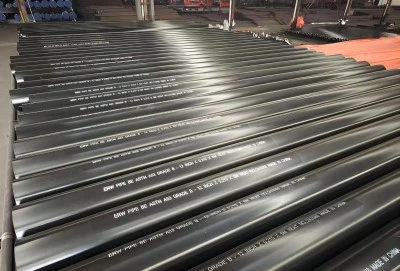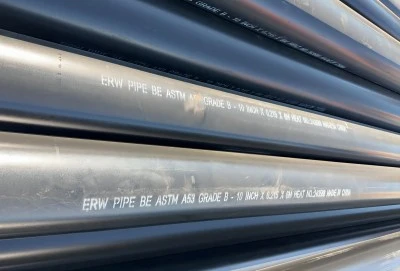ASTM A53 Gr B pipe is a widely used standard in the oil and gas, water supply, and construction industries. These pipes are known for their exceptional strength, durability, and versatility. Understanding the tolerances and dimensional standards for A53 Gr B pipes is crucial for engineers, project managers, and contractors working on large-scale projects. This comprehensive guide delves into the specifics of outside diameter, wall thickness, length, and straightness tolerances, ensuring you have the knowledge needed to make informed decisions in your next project.
|
|
|
Understanding Outside Diameter and Wall Thickness Tolerances
ASTM A53 Gr B OD Tolerances: What You Need to Know
Outside diameter (OD) tolerances are critical in ensuring proper fit and function of ASTM A53 Gr B pipes. These tolerances vary depending on the pipe size and manufacturing method. For welded pipes, the OD tolerance is typically ±1% of the specified OD, with a minimum of ±0.031 inches. Seamless pipes have slightly different tolerances, ranging from ±0.5% to ±1% of the specified OD.
It's essential to note that these tolerances can impact the pipe's compatibility with fittings and connections. Engineers and procurement managers should carefully consider these tolerances when selecting pipes for specific applications, especially in high-pressure systems or where precise fits are required.
Wall Thickness Variations in A53 Grade B Pipes
Wall thickness is another crucial aspect of ASTM A53 Gr B pipe specifications. The standard allows for a variation in wall thickness, typically -12.5% of the nominal wall thickness. This tolerance ensures that the pipe maintains its strength and pressure-bearing capabilities while allowing for minor manufacturing variations.
Understanding these variations is particularly important for projects in the oil and gas sector, where pressure ratings and structural integrity are paramount. Plant equipment managers should be aware of these tolerances when selecting pipes for different sections of their facilities, ensuring that the chosen pipes meet the specific requirements of each application.
Measuring Techniques for Accurate Pipe Dimensions
Accurate measurement of pipe dimensions is crucial for quality control and project success. Modern measurement techniques include ultrasonic testing, laser scanning, and digital calipers. These methods provide precise measurements of OD, wall thickness, and ovality, ensuring that pipes meet the required specifications.
For large-scale projects, implementing a robust quality control process that includes regular dimensional checks is essential. This approach helps identify any deviations early in the project, preventing potential issues during installation or operation.
Length and Straightness: A53 Gr B Pipe Standards
Standard Lengths for ASTM A53 Grade B PipesASTM A53 Grade B Pipes are typically available in standard lengths, which can vary depending on the manufacturer and specific project requirements. Common lengths include 20 feet (6.1 meters) and 40 feet (12.2 meters). However, custom lengths can often be ordered to meet specific project needs.
When planning large-scale projects, such as oil and gas pipelines or water supply systems, considering the standard pipe lengths can significantly impact logistics and installation efficiency. Project procurement managers should work closely with suppliers to optimize pipe lengths, reducing the number of joints and potentially lowering overall project costs.
Straightness Tolerances: Ensuring Pipe Alignment
Straightness is a critical factor in pipe installation, particularly for long-distance pipelines and structural applications. ASTM A53 Gr B pipes have specific straightness tolerances, typically not exceeding 0.030 inches multiplied by the number of feet of total length divided by 10.
For offshore platform construction and bridge projects, adhering to these straightness tolerances is crucial for structural integrity and proper load distribution. Engineers should factor in these tolerances when designing support systems and calculating stress loads on the pipes.
End Finishing Options for A53 Gr B Pipes
ASTM A53 Gr B pipes are available with various end finishing options to suit different joining methods and applications. Common options include plain ends, beveled ends, and threaded ends. The choice of end finishing can impact installation time, joint strength, and overall system performance.
For projects in regions like the Middle East or Southeast Asia, where environmental conditions can be harsh, selecting the appropriate end finishing is crucial. Beveled ends, for instance, are often preferred for welded joints in high-pressure applications, providing a stronger and more reliable connection.
Impact of Tolerances on Pipe Installation and Performance
How Tolerances Affect Welding and Fitting ProcessesThe tolerances of ASTM A53 Gr B pipes have a direct impact on welding and fitting processes. Variations in outside diameter and wall thickness can affect the quality of welds and the ease of fitting connections. Skilled welders and fitters must be aware of these tolerances to ensure proper joint preparation and execution.
In industrial manufacturing settings, where precision is key, understanding these tolerances helps in developing effective welding procedures and selecting appropriate fittings. This knowledge can lead to improved productivity and reduced rework, ultimately contributing to project efficiency and cost-effectiveness.
Pressure Ratings: Influence of Dimensional Variances
Dimensional variances, particularly in wall thickness, can affect the pressure ratings of ASTM A53 Gr B pipes. While the standard allows for some variation, it's crucial to consider the minimum wall thickness when calculating pressure capacities for critical applications.
For projects in the oil and gas transportation sector, especially those involving high-pressure systems, engineers must carefully evaluate the impact of these variances on system design and safety factors. This consideration is particularly important for projects in regions like Australia, where stringent safety standards are enforced.
Quality Control Measures for A53 Gr B Pipe Manufacturing
Maintaining tight quality control during the manufacturing process is essential to ensure ASTM A53 Gr B pipes meet the required tolerances and performance standards. This involves regular inspections, dimensional checks, and material testing throughout the production cycle.
Advanced production facilities employ state-of-the-art testing equipment, including ultrasonic flaw detectors and X-ray systems, to identify any defects or variations that may affect pipe performance. For large-scale engineering projects, partnering with manufacturers who have robust quality control processes can significantly reduce the risk of pipe-related issues during installation and operation.
Understanding the tolerances and dimensional standards of ASTM A53 Gr B pipes is crucial for ensuring project success in various industries. From oil and gas transportation to water supply systems and structural applications, these pipes play a vital role in modern infrastructure. By considering factors such as outside diameter tolerances, wall thickness variations, and straightness standards, engineers and project managers can make informed decisions that enhance the efficiency, safety, and longevity of their projects. As the global demand for reliable piping solutions continues to grow, staying informed about these standards will remain a key factor in delivering successful engineering projects across diverse geographical regions.
Longma Group ASTM A53 Gr B Pipes
When seeking high-quality A53 Gr B Pipes for your next project, consider Hebei Longma Group. Our advanced production equipment, imported from Germany, ensures precision manufacturing. With a professional team of over 300 employees, including 60+ technical experts, we guarantee top-notch products. Our comprehensive testing facilities, including ultrasonic flaw detectors and X-ray equipment, ensure every pipe meets stringent quality standards. We offer fast delivery, with standard thickness pipes ready in as little as 7 days. Our complete certification, including API 5L and ISO 9001, demonstrates our commitment to quality. Thanks to our integrated production model and strong supplier relationships, we offer competitive pricing without compromising on quality. For reliable ASTM A53 Gr B pipes that meet your project's exacting standards, contact us at info@longma-group.com.














